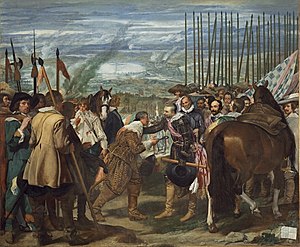The handover of Breda

|
| The handover of Breda |
|---|
| Diego Velázquez , around 1635 |
| Oil on canvas |
| 307 × 370 cm |
| Museo del Prado |
The Surrender of Breda is a painting by the Spanish painter Diego Velázquez . The 3.70 × 3.07 meter picture, which is called "Las lanzas" in Spanish, was created around 1635 and is now hanging in the Museo del Prado in Madrid .
Historical background
During the Eighty Years' War until the middle of the 17th century, Spain fought to maintain Habsburg power over the Spanish Netherlands , whose Protestant part had fallen away from Spain in the form of the Union of Utrecht , while Flanders had been occupied and re-catholized by Spanish troops after initial uprisings. The town of Breda was considered to be the key . Philip IV , king since 1621, demanded a victory, although his council of war had warned of the risk of trench warfare. He sent his general in the Netherlands, Ambrosio Spinola , a note with the request: “Take Breda” and the signature: “I, the King” . The siege of Breda lasted 12 months , during which the Spanish army was also severely decimated, but on June 2, 1625 the commander of the Dutch army signed the document of surrender.
The paintings
Velázquez was commissioned to capture the victory of the Spaniards over the Dutch in the picture. He decided on the scene in which the Dutch commander Justinus von Nassau hands over the city key to the Spaniard Spinola. In a report from Antwerp from 1629 it says about the process: "He ( Spinola ) greeted and hugged the commanding officer of Nassau with a friendly look and praised the bravery of the defense in even friendlier words." In the picture, the representative of the defeated Dutch appears (left) towards the victorious Spinola (right) in humility and is raised up by him. According to the ancient historian Pedro Barceló , Velasquez took the gesture of political generosity during his visit to Rome from a depiction of the Emperor Trajan , which was inserted into the triumphal arch of Constantine .
According to historical evidence, Spinola made the terms of surrender very generous: the opposing soldiers were allowed to leave the city fully armed and in formation; the Spanish army was not allowed to plunder. The Spanish public was enthusiastic about this noble gesture, not only Velázquez put it in the picture, the poet Pedro Calderón de la Barca also celebrated Spinola in his play “The Siege of Breda” .
The painting is also called “Las lanzas” in Spanish because a good third of the upper area of the picture is filled by the threatening, gigantic lances of the Spanish army. They were feared for their range and power. Carried vertically in a formation, they looked like an impenetrable wall, and Calderón gave it the name "Cornfields". In the painting, however, the lances are not all vertical. Among the men of the Spanish army, most of whom are depicted only very vaguely, quite a few did not follow the gesture of defiance by removing their hats; they kept their hats on, did not turn to the ceremony, but appeared to be turning instead to chat. By staging this lack of discipline in attitude and behavior, Velázquez drew attention to the state of the Spanish army: at the time, it consisted mainly of recruited mercenaries of foreign origin who fought for starvation wages on either side without any impetus of their own. You will not have liked it that Spinola had forbidden the marauding in the city of Breda. On the far right of the picture, behind the horse and below the flag, a member of the Spanish army looks out of the picture, his facial features are those of the painter.
literature
- José Lopez-Rey: Velázquez. Painter the painter. Catalog raisonné. Vol. 2. Cologne: Taschen, Wildenstein Inst. 1996, Cat. No. 73. ISBN 3-8228-8723-4 .
- Rose-Marie and Rainer Hagen: Image surveys - masterpieces in detail , Benedikt Taschenverlag Cologne 1994.
- Norbert Wolf : Velázquez , Benedikt Taschen Verlag Cologne 1999, ISBN 3-8228-6376-9 .
- Bernd Wolfgang Lindemann : Humility and justification - layers of meaning in the handover of Breda by Diego Velázquez. In: Thinking in Pictures. 31 Positions on Art, Museum and Science, ed. by Günther Schauerte and Moritz Wullen, Ostfildern 2008, pp. 114–121. ISBN 978-3-7757-2324-4 .